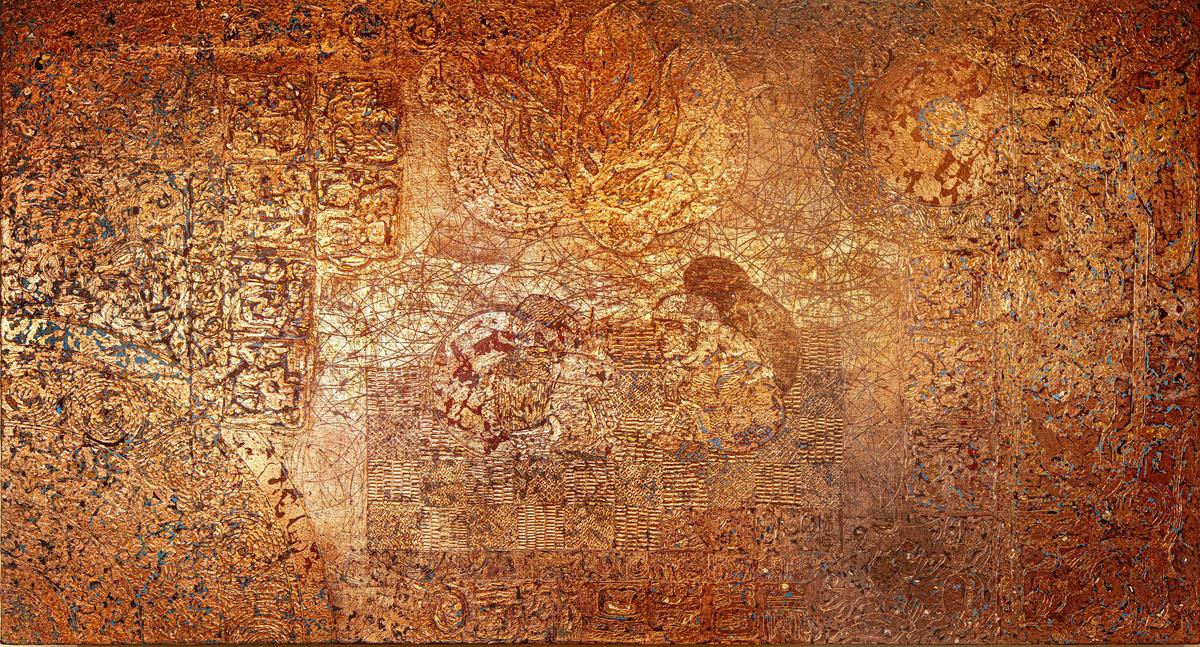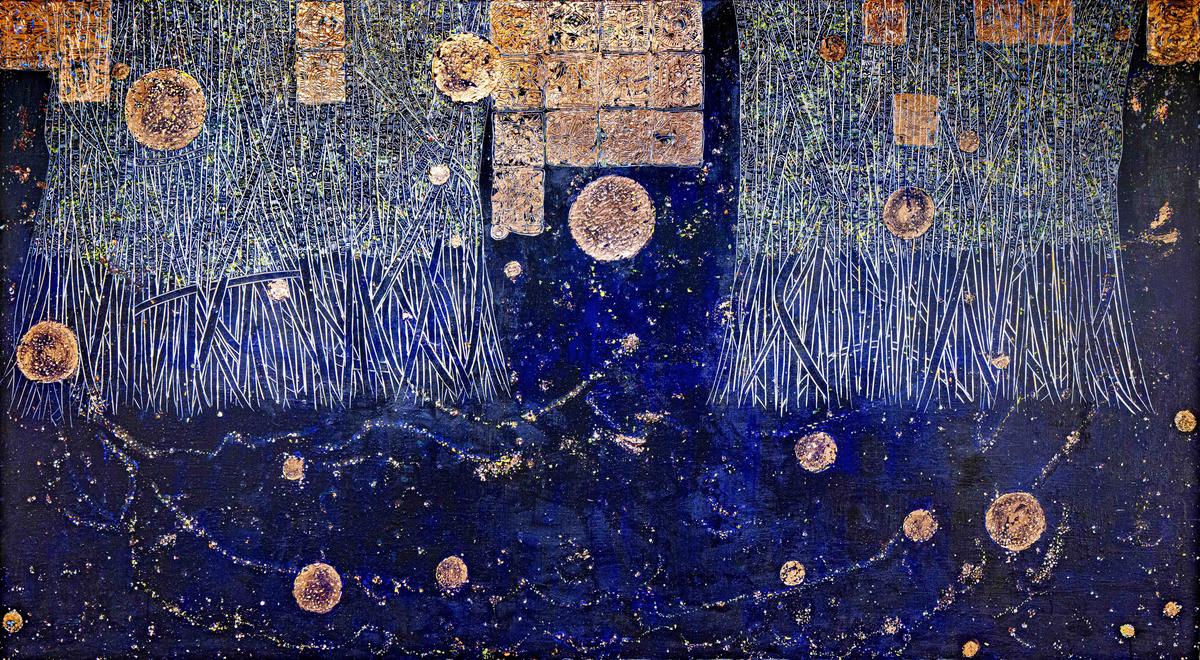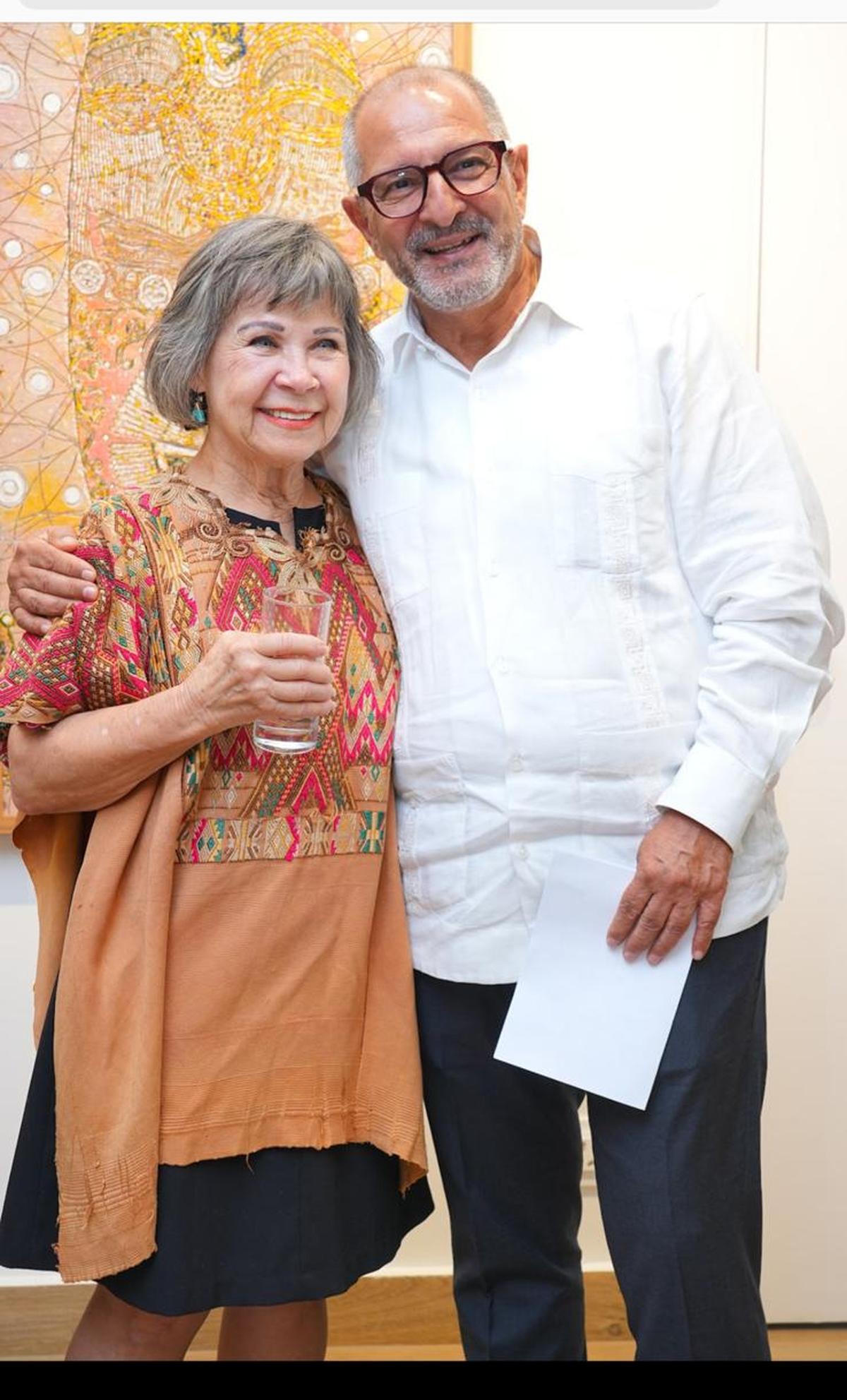“Women are invisible to the male gaze, except in the area of lust. All their other accomplishments, talents and capabilities go unnoticed,” says Eva Malhotra. Perhaps an unusual statement from an artist when discussing her exhibition in Bengaluru, but not as strange as her life experiences that mirror the ordeals of women the world over.
The seven canvases on display in her series, Call to the Mystic, are an unusual presentation of space, time and the universe, as well as the sacred and scripts, rendered as abstracts. Executed as carved acrylic and copper foil on canvas, each of the pieces evoke a sense of mystery, wonder and curiosity.
Early grounding
Born to an American father and a mother who was Mexican, Eva spent the first 10 years of her life in Mexico before relocating to Los Angeles. “We lived quite close to the border in Mexico and we’d cross into the United States to attend school everyday. But even as a child I’d see how differently I was treated in comparison to my cousins because I looked more ‘American’ than them,” says Eva.
Growing up in a huge joint family in Mexico, Eva says her home was brimming with cousins, uncles and aunts, a few of whom were in the same age group. “The conversations around the dining table revolved around politics and current affairs, and opened my understanding to the world outside.”
Artist Eva Malhotra
| Photo Credit:
Special Arrangement
“My paternal grandfather was a commercial artist and his paints and works were always around. There was also a piano in the house so we all grew up exposed to art and music as well.”
Sadly, a series of tragic events marked Eva’s childhood. The death of a baby brother, the long hospitalisation of her mother and sibling, as well as the separation of her parents, not only left a deep impact, but also exposed her to the ugly realities of religious prejudice, disparity, abuse and racism. It is ironic how goddesses are revered but women are disrespected on so many levels.
“I was made aware of the discriminatory treatment that religion brings, even though Jesus Christ and his teachings are inclusive, and all these injustices developed my critical thinking skills at a young age,” she says.
School in Mexico inculcated in Eva a pride in ancient Mexican culture and civilisation. “The world only knows about the Mayans and Aztecs, but the Olmecs, Teotihuacans and Toltecs, were no less in any way. We had a formidable past that colonisers suppressed, and after settling in America, I refused to buy into their discrimination against Hispanics.”
Work in progress
Eva says her mother was quite keen that she got a good education, and “always encouraged us to to become professionals” as she knew first hand how important it was. “My mother would regularly take us to the local library and I was extremely interested in mythology and fairy tales,” she says, adding that it led to a fascination with Spanish literature which she began to study.

A piece from Call To The Mystic by artist Eva Malhotra
| Photo Credit:
Special Arrangement
Eva paired her social awareness and childhood experiences with classes in political science, history and economics, along with art theory, eventually becoming a lawyer. It was while she was studying at Berkeley, that she met Krish Malhotra was doing his LLM (Master of Laws), and they got married.
During a visit to the Asian Art Museum in San Francisco, a piece of art by a Japanese artist on dark wood, fascinated Eva. “It was a carving and it captivated me. I felt like the breeze flowing through the grass in that piece and it inspired me to work with wood.”
“I began collecting little items I would find in the street — nails, wires, pieces of glass or stones — and hammer them into wood to create my many-layered compositions.”

A piece from Call To The Mystic by artist Eva Malhotra
| Photo Credit:
Special Arrangement
A series titled Cosmos was well received and as she progressed with her art, she took to using lacquer and creating encaustic works where heat is used throughout the process, to fuse layers of different media onto the canvas.
However, her innovative ideas turned out to become a creative channel of all the trauma she had undergone. “I was working with wood carving tools, experimenting with the medium and technique, making aesthetic choices based on volume, form, line and harmony.”
“But importantly, what I found was that the movement and rhythm, were building emotional strength in me,” says the artist, adding that the act of gouging, nailing and scraping at those pieces were cathartic. “After a while, I started adding natural dyes such as turmeric and indigo as well as oil colours into the grooves.”
“Sometimes while I would be working it would almost be like uncovering an old scar, and it would bring up painful memories.”
“I remembered the sexual abuse I had suffered as a child and the unjustified feeling of shame, responsibility, guilt and fear it had created in me. Due to the early onset of adolescence, I was preyed on by men and bullied by my peers. The humiliation and isolation found visceral expression in my work. The series was titled Vulnus, which in Latin means wound.”
That was Eva’s first exhibition and she was in her mid-50s at the time.
Even as she found her groove, the NAFTA Treaty (1994) between the United States and Mexico came into effect and Eva says she saw how the economy birthed a floating population of working women. “It lead to more exploitation as well as human and organ trafficking,” she says.

Artist Eva Malhotra with Frederico Salas, Ambassador of Mexico to India, at GalleryG
| Photo Credit:
Special Arrangement
“It also resulted in a rise in femicides in Mexico. Over the years, I have studied femicides and discovered it happens all over the world. In Mexico, there are stabbings, whereas in the Middle East it’s by pelting women. Guns are used in the United states and in India, they are burnt,” says the artist, who has lived in India too.
Shape and form
Not all of Eva’s works are executed on canvas — some have been sculptures and art performances too, such as Requiem For a Woman, while This Silence Is Killing Me, came about when she experimented with oils on silk and the horrific memories of abuse came rushing back with the feel of that fabric. However, she says not all her art stemmed from dark incidents, “there were moments of glee and wonder too, that found a place in my creations.”
She recalls an African objet d’art which was embedded with circular mirrors. “As I picked it up, I caught my eye in that mirror, it was one of the most electrifying experiences I had. I saw my gaze was totally different from how I see myself. It was quite impactful because we never really see ourselves as we truly are. We see ourselves as others see us.”
“The mirror mosaic singled out certain features as well as attitudes reflected in the way you hold your chin or the way you smile, with just your lips or your eyes, and much more. I thought that was an interesting discovery and it led to whole series called Through the Looking Glass.”
“It is about introspection. If we are honest with ourselves, we are constantly looking to see if our conduct is consonant with our values and how we perceive ourselves. While it can entail constant self criticism, to me, there is something almost sacred about how you see yourself, when you are truly looking inward.”
World art
Every series Eva has worked on has originated from the impact of happenings around her whether it was Bajo la Misma Luna (about borders created by nations or formed based on status, gender preference, religion or identity) or Murmullos inspired by Mexican writer Juan Rulfo “whose works are like an abstract painting; you can interpret it a million different ways.”

Eva Malhotra encourages visitors to feel the texture of her work
| Photo Credit:
Special Arrangement
This series inspired by Juan Rulfo is currently on display in Chile along with works of art by Juan’s son, Pablo Rulfo.
Call to the Mystic came about in a similar fashion. “India is a spiritual and mystical place; I could connect with it as I did with my ancestors, the original people of Mexico.”
“The Mayans were great astronomers and had much knowledge of the universe and the movement of the moon, the planets and stars. They had about 20 calendars which they would follow for training or to heal, physically, mentally and emotionally. They also had spiritual guides called the Counters of Time and one of my pieces in this series is named so as well.”
Unlike other exhibitions, Call to the Mystic invites visitors to touch the works of art and revel in its texture, because “you can never really know my work unless you see it not only with your eyes, but also your hands. When you touch it, you will verify what you are looking at and gain a deeper understanding of my work.”
Two pieces from Call to the Mystic — The Counter of Time and In Illo Tempore — will be at the Bihar Museum Biennale in Patna this year from August 7, till the end of the year. Eva will be part of a seminar on issues of Empathy, Memory and Conflict Within Museums on August 8 at the same venue.
Inspired by mythology and ancient texts Call to the Mystic by Mexican artist Eva Malhotra is a celebration of 75 years of diplomatic relations between Mexico and India, and was introduced in the city by HE Frederico Salas, Ambassador of Mexico to India, and Sandeep Maini, Honorary Consul of Mexico in Bengaluru.
Call to the Mystic will be on display at Gallery G till July 14, 2025



